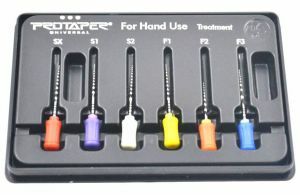 The new "drill rule", or the union of physiology and physics.
The new "drill rule", or the union of physiology and physics.
Proteippers( both machine and hand) have significant differences from those used in dentistry before the root files( boraws).Not scolding the past, it is worth noting: the root drills had the limits of application possibilities.
The very form of the product( cross-section with spiral swirling cutting edges) required utmost attention in the management of the tool - the risk of its fracture was high, the brittleness of the steel used exacerbated the risk;for the same reason, type H was dangerous and categorically forbidden to make rotational movements.
With K-bits with a square cross-section of the cutting part and greater fracture strength, the probability of perforation of the tooth increased due to the presence of a dangerously acute tip.
A uniformly cylindrical shape of both types of tools required the use of a large set of files with different diameter of the cutting segment.
Contents
- Advantages and disadvantages of nickelitene files
- About the group of initiating files
- Finishing tool for machining
- For manual work
- How to use profiles
- Toolkit for retreat
- Features of application
- Nuances and tips
Advantages and disadvantages of nickelitene files
Use of innovativetoolkit allows to reduce to a minimum the arsenal of files consumed for working out of root cavities of files and, Unstable "uncontrollability" unit, to minimize the possibility of its fracture and the risk of perforation of the tooth.
For, unlike its predecessors, the profile of the latest generation has the shape of a cone tapering uniformly to the tip.
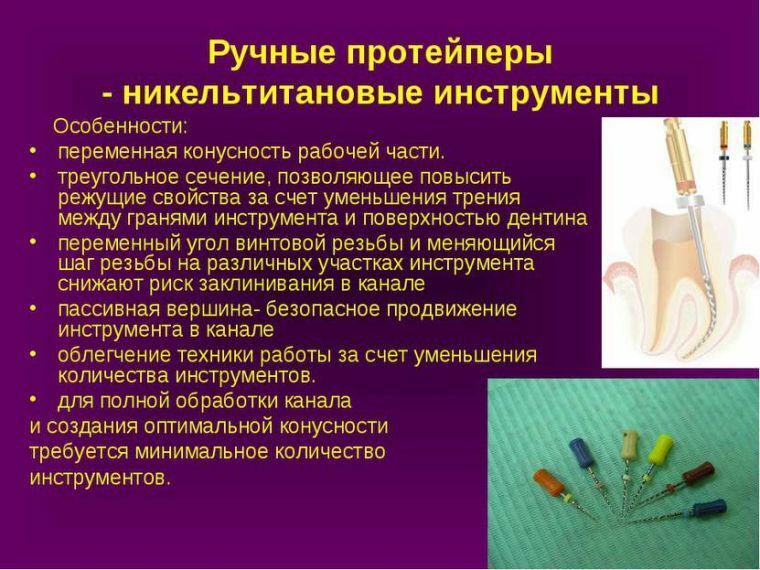
A high degree of flexibility combined with strength is ensured by:
- nickel-titanium alloy composition from which the files are made;
- section in the form of a triangle with convex sides, reducing the area and time of contact of the blade with the treated walls, and the safety of the intervention minimizing;
- with the multistage taper of the ProTaper cutting zone with adequately the stage objectives by varying angles and steps of the spiral working area, allowing the tool to cut a minimum layer of tissues, reducing the risk of both jamming it and channel obturation.
The cutting edge efficiency of the prototype, which reduces the number of penetrations necessary for channeling, is reached by an adequate stage by the growth( progression) of D0 - the diameter of the apical cone of the unit as it moves from the previous file to the next one.
Due to its ProTaper design:
- gives the working area a configuration in which uniformity of constriction in the apex direction ensures uniformity of the thickness of the walls of the root canal;
- provides passage and processing channels of the most complex shape.
In addition to this, the advantages of using titanium files are: 
- the obviousness of the sequence of application due to the color marking;
- speed of execution of the operation, since there is a need to apply a set of only 3 tools;
- provides security for manipulating the rounded tip( guaranteeing the perforation of the tooth due to deviation from the channel axis) and the ability to process the channel with a hand tool with high clarity of tactile sensations.
To drawbacks of the retailers, it is necessary to refer:
- limited possibilities for working channels with a wide( more than 30 size) diameter of the apical opening - the creation of a tool with a large apical diameter is not provided;
- restriction on the depth of the treated cavities - the maximum length is 31 mm;
- an unintended mechanism of preventing obturation - leaving a significant lubricated layer on the walls of the channel and preventing access to them for medication to treat the canal.
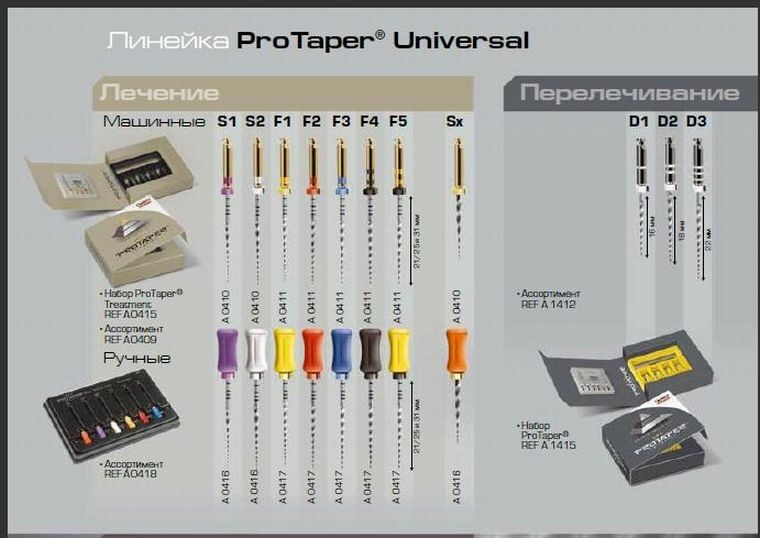
About the group of initiating( forming) files
The purpose of the group( traversing the root channel with giving it the necessary configuration) determines the design features of the files included in it.
The basic shaping shapers( No. 1 and 2, or S1 and S2) have the following characteristics:
- with a cutting length of 21 or 25 mm;
- with diameters D0 equal to 0.17 and 0.20 mm respectively;
- maximum diameter of the notches, in D14 approaching 1.20 mm;
- with a modified guide apex cone, have a progressively increasing taper of blades, allowing each file to dissect only a certain required area.
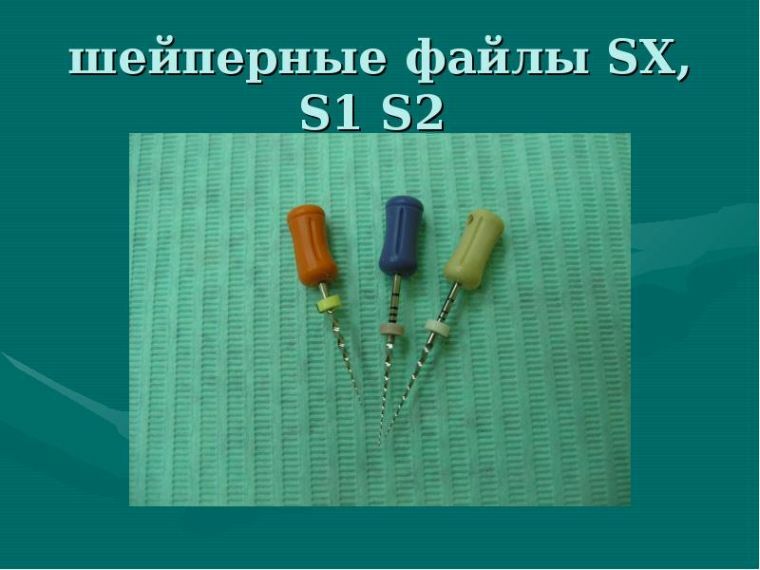
For the auxiliary shaper Sx( or X), which serves as an adaptation for the processing of short root canals, 9 levels of taper( from 3.5 to 19%) are provided for recognizing the direction and forming a convenient configuration of long channels in their coronal zone for easy cutting of the back-cleaning movements segment D6 - D9.
And the growth of the conicity from D1 to D9( from. 035 to. 19) is replaced by its subsequent decrease( to. 02).The shaper differs with a gold-painted handle without an identification ring.
For File 1( with a taper from. 02 to. 11), this is the study of the coronal third of the channel, for file number 2( with the build-up of the taper from 0.04 to 0.115 in D16) - the expansion and preparation of its middle third. While both prototypes optimize the configuration of two-thirds of the coronal fragment of the canal, they also serve for the successive expansion of its apical third.
The tools are easily recognizable thanks to the handles with correspondingly purple and white rings on them.
Finishing tools for machining
Finishing tools F1, F2, F3 have the final formation of the apical third of the root canal and its alignment in the middle third. But usually for the development of the apical third there is only one finish file.
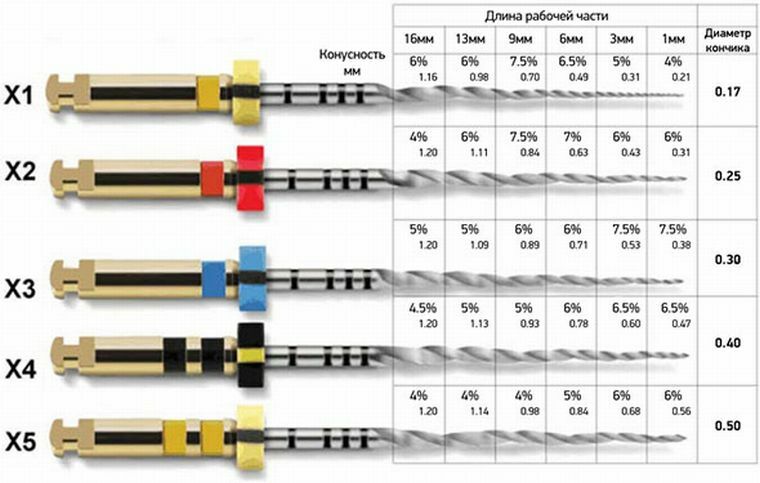
Tool kit ProTaper Next
The peculiarity of their geometry is the different level of taper of different segments of the blade. For D0:
- of 0.20 for F1;
- in 0.25 for F2;
- in 0.30 mm for F3.
The taper in D0-D3 is fixed at 7, 8 and 9%.
Throughout D4-D14, each tool with a steady increase in diameter has a decreasing percentage of taper. Such a constructive "zest" allows for greater flexibility of individual fragments of the blade of the file, reducing the risk of blocking the instrument.
Marking of finish-manufacturers is a ring on the handles of yellow, red and blue in accordance with the diameter of the blade and the sequence of application of the tool.
For manual work of
Manual handlers are applicable for the same manipulations as machine ones, they have the same alphanumeric designation.
In a standard set of 6 tools with different colors of handles in accordance with their technical data:
- Sx - c orange;
- S1 - with purple;
- S2 - with white;
- F1 - with yellow;
- F2 - with red;
- F3 - c blue.

Protaper S2
The manual ProTaper Sx is represented by one modification - 19 mm, the active tool zone length S1, S2, F1, F2, F3 is 25 or 31 mm.
Manual files F4( with black handle) and F5( with black and yellow) with an active area of 25 mm are designed for both initial and final processing of the root canals.
How to use profiles
Creating rectilinear access to the root of the root canal is done by removing the roof of the pulp chamber and the excess of the dentin tissue protruding along its edges.
Preparation and smoothing of the inner walls is performed, supplemented if necessary with the expansion of the crown zone for ease of access to the mouth with the exception of interference for subsequent processing.
The purpose of manipulation is the visibility of the mouth without changing the position of the mirror, the tool should be freely inserted into the mouth of the canal and easily slid along the smooth walls of the pulpary cavity.
The key to the success of the manipulation is the regularity of irrigation and checking the patency of the guide track with a hand tool of 15 numbers according to ISO.
Treatment stages:
- After localization of the mouth, passive application of the manual ProTaper 15 numbers is performed until resistance appears.
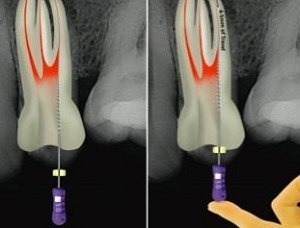
- By sweeping motion file with S1 file, it is necessary to achieve the penetration depth of the above-mentioned manual file.
- The sequence of movements is made before the passage of the channel by the tool S1 to the full depth( according to the data of the manual file 15 size).
- With the use of sweeping motions by the S2 driver, a confirmed passage of the channel to full working length is achieved.
- Using finisher F1( without using sweep simulation), move it forward along the channel until it reaches the working length.
- Calibration of the apical opening is performed using manual files of the appropriate diameter.
- For additional expansion of the apical aperture or at its larger size, use finishers F2, F3, F4, F5, using their entire working area without sweeping movements.
- In order to remove dentin from the mouth and widen the coronal area of the canal, sweeping movements of the ProTaper Sx are used.
The
retreatment tool The standard consists of a set of 3 sequential attachments( D1 - D2 - D3) with different lengths and taper of the blade, designed for ease of teeth rasplombirovaniya.
The shortest tool D1 serves for penetration of the crown, medium D2 for the median, the longest D3 for the apical canal zone.
In addition to the dark gray color of the handles with a length of not more than 11 mm, the simplicity of the application algorithm( from the shortest to the longest) is provided by the presence of one, two or three white rings on the handles, respectively.
The active cone-tip of the initiating file D1 facilitates the initial penetration into the roots.
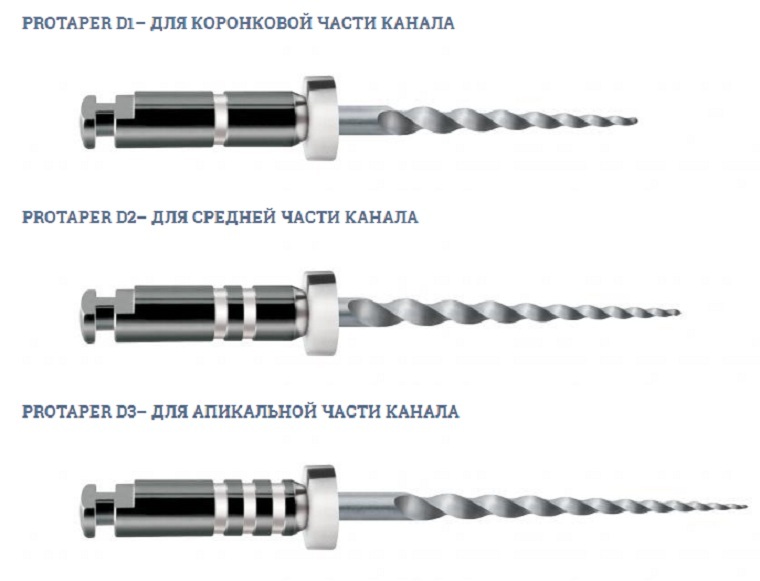
Features of the application of
Rules for the use of prototypes removal of filling compositions from the root canals is carried out with several absolute conditions.
- introduction is carried out with the use of relatively easy pressing in the direction of the apex of the tooth;
- tool is methodically extracted from the channel for inspection and cleaning of the working surface;
- , if the tool is not moved in depth, a manual file is used to facilitate the removal of the obstacle, the same measure is used to confirm the passability of the required zone;
- compliance with the recommended speed for extraction: gutta-percha and Thermafil obturators: 500-700 rpm;pastes containing zinc oxide and eugenol: 250-300 rpm.
Nuances and tips
Protekers of any category can be used only in clinical settings, only by appointment and exclusively by specialist dentists.
The precautionary measure is the prohibition:
- for the reuse of disposable instruments;
- for the use of disinfectants with unconfirmed efficacy;
- for immersion of titanium-nickel profiles in a solution of sodium hypochlorite with a concentration exceeding 5% for a period exceeding 5 minutes.
Cleaning, disinfection and sterilization must be carried out in strict accordance with the rules developed and recommended by the equipment manufacturer, as well as compliance with the algorithm of actions when applying them.
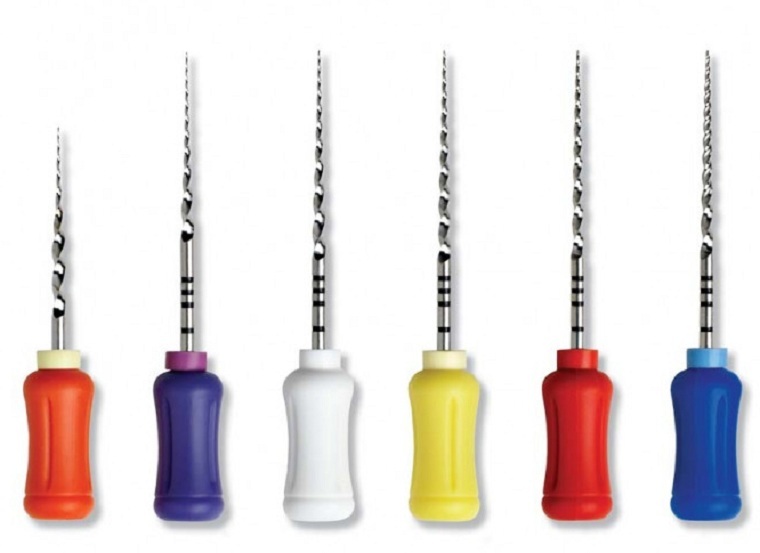
Set Maillefer
On average, the price of dialing from the Swiss manufacturer Maillefer is 1860 rubles( both for a set of manual and machine protypes in the amount of 6 pieces).
